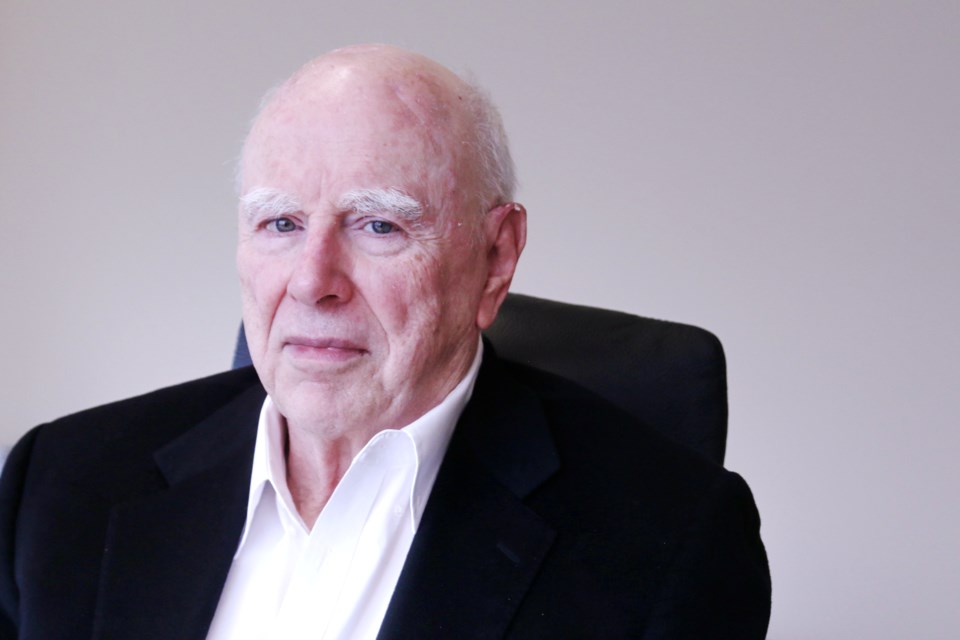Business in Vancouver’s weekly print publication has reached 1,800 editions that span three and a half decades.
When the paper published its first issue 35 years ago, BIV’s future seemed anything but certain. Financing was in place, but the venture was in debt from the start and facing a lawsuit.
On the eve of the publication of its first edition, BIV faced court action from the now-extinct competitor Vancouver’s Business Report, which alleged that the Business in Vancouver name sounded too similar and would confuse the public, co-founder and inaugural publisher Peter Ladner told BIV.
“If it hadn’t gone in our favour, we would have lost the entire run and had to start again with a new name, even deeper in debt than we already were,” he said.
Aiming to provide essential business information for readers and advertisers, BIV’s first edition rolled off the presses dated Sept. 11, 1989, following months of behind-the-scenes planning.
Ladner had teamed up with George Mleczko to raise $1 million – a sum they considered to be the minimum amount necessary to sustain the publication of a weekly print edition until sufficient advertising revenue materialized.
Ladner had publishing experience, having produced the Vancouver’s Business Report before he sold the publication to what turned out to be a litigious new owner.
Mleczko’s career had taken him from sales at the Toronto Sun and Edmonton Sun, and later Equity Magazine, to serve as then-publisher of B.C. Woman to Woman Magazine.
Other early investors included Buy&Sell founder Mike Abbott, John Collison and a man Ladner described as pivotal: Art Rennison.
Rennison, he said, enlisted a team of investors to give BIV sufficient financing to weather those tumultuous and uncertain early days.
“I’m proud to say that our original investors – family, friends and acquaintances – all made their money back and more,” Ladner said.
Original BIV circulation manager, Scott Wheatley, remembered some dire times at the outset.
“BIV wasn’t doing very well,” said Wheatley, who currently serves as executive director of the Cloverdale Chamber of Commerce. “It was losing money, and at one point we all had to take a 10-per-cent cut in pay to avoid the company failing. To the company’s credit, when things turned around, they paid us all back either in stock or cash. We had the option.”
Wheatley said that his job might have been easier if BIV had chosen one of the other names that had been considered: Business This Week.
“The biggest part of my job was selling subscriptions,” he said. “Everybody outside of the city of Vancouver thought it was just Vancouver news, and not news from the region, so that was always a challenge.”
He said he remembers that the company printed 20,000 copies each of its first editions.
After a 48-page, Sept. 11, 1989 “preview issue,” the next edition was published nearly a month later and dated Oct. 2. Sales staff used those intervening weeks to show the publication to potential advertisers and acquaint them with how the paper would look, Wheatley said.
BIV mailed to specific businesses complimentary copies accompanied by flyers urging executives to subscribe, as free copies would not arrive each week.
Once paid circulation rose to 6,000, the paper scaled back its print run to 12,000 copies because Canada Post provided a significant postage-rate discount if the publication had half of its print run sent to paying subscribers, Wheatley explained.
BIV covered content overlooked by other media
The inaugural edition of BIV included sections that would become staples of the publication.
One section listed businesses being sued, and by whom – a popular feature BIV continues to this day for subscribers.
The inaugural edition also included what was called, “The list.” The first list identified the top 15 convention and conference facilities in Metro Vancouver.
BIV has produced hundreds of lists since, and has for years published an annual Book of Lists that features most of the lists researched and produced by BIV over the past year, including lists of:
• The province’s highest-paid, public-company executives;
• The Top 100 fastest-growing companies in B.C., ranked by revenue over a five-year time span; and
• B.C.’s largest corporate transactions, ranked by value.
Other sections in that first issue of BIV included a list of TV and movie shoots happening around town, “people on the move” – which highlighted those getting promotions or changing jobs – and a section documenting newly-issued business licences. There were also a list of job openings and a “datebook” section filled with luncheons, meetings and events.
What BIV called its “association profile” in that inaugural issue was a feature on the Retail Merchants Association of B.C. and its president Mark Startup.
“I’m sure that profile helped get new members,” said Startup, who retired from his role at the Retail Council of Canada just before the COVID-19 pandemic.
“As we became more and more involved in issues, any media coverage that we got – and we had a significant amount of media coverage in BIV over the years – it could be galvanizing.”
He hailed BIV for becoming an advocate and voice for province’s small-business sector, and for probing into issues more deeply than other publications.
“You might read a good story in the Vancouver dailies, but you’d wait to get the full story in BIV,” he said.
“I remember when we made it to the list of largest associations. It was like, ‘Holy cow, we’re on the BIV list.’”
Startup also said he would regularly check BIV to see if members of his association were being sued.
Michael Audain, chair of Polygon Homes Ltd., was featured in the second print edition of BIV when, as he recalled, his company was partially acquired by an international conglomerate called P&O Ltd.
“I was delighted to see the newspaper start,” said Audain, whose business leadership and philanthropy have been featured in many of the 1,798 print editions published by BIV since Oct. 2, 1989.
“I think I speak for many of my colleagues in the business. We are very interested in learning more about what’s going on in the province, and we look to Business in Vancouver to assist us in that area.”

Michael Audain was featured in the second edition of BIV, in 1989 | Rob Kruyt, BIV
Awards, innovation and recognition
Throughout its 35-year history, BIV also became known for the work it has done outside the pages of its weekly print edition – work that included the creation of innovative awards programs and special magazines dedicated to distinct communities.
That entrepreneurial spirit continues under different leadership, exemplified by the launch of news products such as an Indigenous business magazine titled Mákook pi Sélim. Co-created by consulting editor Chastity Davis-Alphonse and current BIV editor-in-chief Hayley Woodin Hastings, the publication started in 2021 and has produced five editions – all of which exclusively feature content written by Indigenous journalists and columnists.
When he was serving as BIV’s publisher, Ladner announced in his one-year anniversary column that the newspaper was launching what he called the Top 40 under 40.
“This is our way of turning the spotlight on 40 top business performers in their fields, people who have beaten the odds of reaching the top before their 40th birthday,” he wrote.
Nominations opened immediately for the first cohort of those awards, now simply known as BIV’s Forty under 40 Awards, and the paper announced its 1990 cohort of winners in January 1991.
The nomination process for the 2024 awards programs closes in mid-summer. Winners will be recognized in the now-annual Forty under 40 magazine in December, and feted at a February 2025 gala event, which will also celebrate 35 years of honourees young B.C. business leaders.
“I was honoured,” Helijet CEO Danny Sitnam told BIV about his reaction to being in the first Forty under 40 Awards cohort. At the time, he was 33 years old and running a three-year-old helicopter airline with four Sikorsky helicopters making 57 scheduled flights on weekdays between Vancouver and Victoria.
“Typically, I am humbled whenever there’s any recognition for myself, and even for my company. I’m proud of what we’ve done, and how we’ve succeeded but when it comes to being recognized, I try to run silent and run deep, if you will. I don’t make a big splash about it. That’s just my nature.”

Some of the other winners in that inaugural cohort included Rocky Mountaineer founder Peter Armstrong, then 38 years old, and software entrepreneur Don Mattrick. Mattrick, then 26 years old, had founded Distinctive Software eight years earlier. Five months after he was recognized by BIV, he sold his venture for US$11 million to Electronic Arts Inc. (Nasdaq:EA).
“Back in that day, $11 million was an astoundingly large amount of money,” Armstrong said of Mattrick’s transaction.
Armstrong said he was honoured and humbled to be included in BIV’s first Forty under 40 cohort.
“It gave me a lot of credibility and it gave me a lot of confidence,” he said. “It was a very nice award to receive. I’ve attended many of the events over the years and I think it is always a great list of up-and-comers.”
Sitnam also graced the cover of BIV in April 1990. The newspaper in its early years ran a large photo of a business leader on each week’s cover, and published a lengthy profile of that leader and his or her company on its inside pages.
Urbanics Consultants Ltd. owner Phil Boname made one of those early covers and he told BIV said he remembered that it created a buzz in the business community.
“BIV was a very exciting newspaper,” he said in March, two months before what would have been his 90th birthday, and one month before his April 6 death from pancreatic cancer.
“It was original and very helpful to the business community. For me that paper has been a wealth of assistance in our business.”
BIV launches Influential Women in Business Awards in 2000
BIV’s first gala event to celebrate its Influential Women in Business (IWIB) Award winners took place Feb. 24, 2000, and included a whopping 22 finalists.
The finalists’ names were announced months before the gala, at which five winners were revealed.
That format has long since changed. BIV now names five or six award winners long before the event, which has been held on or near International Women’s Day (March 8) for many years.
“By having a whole bunch of finalists, you could sell a lot of tables – that was the strategy,” said Ladner, who was a driving force behind the creation of the awards program.
“For the finalists, if they are going to win, they want to be there, and they are going to bring friends and colleagues. Of course, the downside was that the more people you had in the room who were not winners, the more disappointment there would be. You did not want to multiply that disappointment more times than you had to.”
Ladner said that BIV was always looking for recognition programs that would compel readers and advertisers.
“Ultimately, that’s what kept the business afloat: Selling ads and creating revenue streams. We had to come up with legitimate awards for recognition that people would pay to read and would lead to paid advertising.”
Celebrating influential women was something Ladner said he heard women wanted.
“Women, young women and girls in particular, need role models,” said Webnames.ca co-founder and CEO Cybele Negris, who is both a past Forty under 40 winner and an IWIB Award recipient.
“In certain industries, you don’t see many female leaders in executive positions or on boards, and when you don’t see role models in those roles, you don’t think you can do it yourself,” she said.
She credited awards BIV bestowed on her as helping her gain confidence and the “credibility and external validation” needed to be asked to join corporate boards.
In addition to being on the board of her own company, she serves on the boards of Science World, the Royal Canadian Mint, BCAA, AGF Management Ltd., Telus Vancouver Coastal Community and the B.C. government’s BC Small Business Roundtable.
She added that being included in BIV’s annual BC500 magazine which profiles 500 influential British Columbian business leaders – is equally valuable as it recognizes her success “not just as a woman, but as a business leader.”
In order to be eligible, IWIB Award nominees must not have previously received the award. An exception is the annual IWIB Lifetime Achievement Award, which has on occasion been given to a previous IWIB recipient.
“I remember when I was told I was nominated,” said Susan Mendelson, who was an IWIB winner in 2001.
She founded the catering business Lazy Gourmet in 1979 and sold the venture last year for a “significant” but confidential amount.
“I was on a chairlift in Whistler when I got the message that I was being nominated, and honestly, it was the biggest thrill,” she said. “Just being nominated blew me away.”
Mendelson was also named a BIV Forty under 40 winner in 1992, when she was 39 years old.
Her IWIB win in 2001 came as her catering business was rapidly expanding, and had become well known in part for providing catering to the Molson Indy Vancouver for nine years. She may have been best known for popularizing Nanaimo bars.
“I think the [IWIB] award was a big win for the whole company, not just me personally, because the team is such a big part of what the Lazy Gourmet is all about,” Mendelson said.

The first cohort of IWIB winners (listed with below with the titles they held in 2000) were:
• Maureen Chant, Jim Pattison Group owner Jim Pattison’s executive assistant;
• Julia Levy, QLT PhotoTherapeutics co-founder;
• Nancy Stibbard, Capilano Suspension Bridge co-owner;
• Gerri Sinclair, NCompass Labs founder and CEO; and
• Nancy Greene Raine, co-owner of Nancy Greene’s Cahilty Lodge.
Greene Raine told BIV that she and husband Al Raine split business tasks. She handled public relations and marketing while he handled the business planning.
“I never really thought of myself as a woman in business,” Greene Raine said. “We certainly were, at that point, very much involved in a hotel that we had at Whistler, and at the Nancy Greene’s Cahilty Lodge [at Sun Peaks]. I always thought of it as Al being in the business side and me being in the fun side.”
Carole Taylor was the emcee and keynote speaker at BIV’s inaugural IWIB Awards gala.
Best known at the time for having been a broadcaster and a Vancouver “alderman,” which is what city councillors were called in the 1980s, Taylor had experience on corporate boards, and had served as chair at Vancouver Port Corp.
Her years overseeing a $1 billion budget as chair of the Canadian Broadcasting Corp., serving as a director of London-based HSBC Holdings and serving as B.C.’s minister of finance were yet to come.
“It was groundbreaking,” said Taylor of BIV launching its IWIB Awards.
“Even if there were other awards for women, this was specifically for women in business.”

BIV would later name Taylor as an IWIB winner and an IWIB Lifetime Achievement Award recipient.
She has since returned to broadcasting and recently wrapped up a 52-episode stint as host of Oh Boy Productions’ BC Legends with Carole Taylor.
“BIV has been a leader in terms of recognizing what women can add around the board table or in the C-suite. I thank BIV for doing that because the number of women who have been recognized over the years has been amazing.”
The awards, she said, raised the profiles of many women and showed that they were qualified to sit on corporate boards.
“More women are having the opportunity to move into senior positions, and are being recognized for their talents, but I have to say that it’s much slower than I expected,” Taylor said.
BIV covers important business trends, zeitgeists
The first edition of BIV landed on desks in a window of time when B.C. business leaders were giddy about the cutting-edge technology known as the fax machine.
Fax machine use in the U.S. grew tenfold between 1985 and 1990 to five million installed machines, according to a scholarly Institute of Electrical and Electronics Engineers article by Texas A&M University associate professor Jonathan C. Coopersmith.
Canadian adoption was likely similar.
“Fax us your news,” BIV wrote in a very large font in what was a nearly full-page advertisement.
“We need your help to give our reporters and writers leads to pursue. Tell us about promotions, new staff, new contacts, new deals, new products, moving or expansion, successes and events.”
Fax machine enthusiasm was fading when technology columnist Alan Zisman started his 17-year stint writing for BIV in 1995.
By then, excitement about the internet, and email, was becoming palpable.
“One of my lessons learned is how we start assuming that as soon as some new technology is announced, that it will be widely adopted overnight,” he said.
“In fact, it takes five to 10 years.”
Sometimes that technology – like the fax machine – fades into irrelevance, he said. Other times, it becomes ubiquitous.
“It then fades into the woodwork because it is commonplace,” Zisman said.

Artificial intelligence (AI) has replaced the metaverse, cryptocurrencies, non-fungible tokens (NFTs) as today’s most-talked-about technology.
“I don’t think AI will disappear but it’s not going to change everything overnight,” Zisman said.
Other BIV columnists similarly covered history in the making.
DIG360 owner David Ian Gray credits his BIV column in the late 1990s and early 2000s with helping him in his business.
He arrived in B.C. from Ontario as a retail consultant with Sixth Line Solutions in the late 1990s.
Ladner was impressed enough with Gray’s insights to offer him the chance to write a column about a year later.
“The newspaper informed me as much as I was informing readers,” he said. “You guys track the retail business in B.C. incredibly well.”
Former Vancouver city councillor Gordon Price wrote a column for BIV when he was in politics, and afterward, when he was director of the city program at Simon Fraser University.
“It was really the rise of Vancouverism, the post-Expo and what is not talked about too much, because it is difficult to get your words around, but the city was ethnically changing,” he said.
Immigration to Vancouver from Asia surged in the 1990s in the lead-up to the British handing political sovereignty over Hong Kong to China in 1997.
Price spent time on council rezoning properties and approving projects that created new communities on the former Expo site, and in Yaletown, Coal Harbour and much of the downtown core.
“Not infrequently, I would formulate my own thinking by having to produce a column for BIV,” said Price, who was Vancouver’s first elected openly gay city councillor.
“As a writer, you often don’t know what you think until you write it down.”
.png;w=960)


